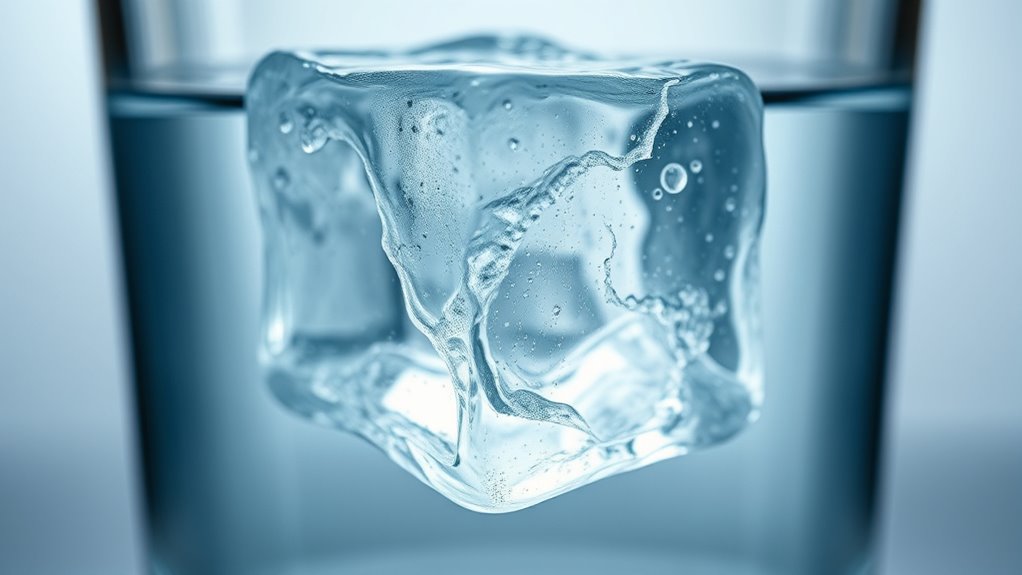Ice floats because water expands when it cools below 4°C, making it less dense than liquid water. This happens because hydrogen bonds arrange water molecules into an open, tetrahedral structure, creating a cage-like lattice that takes up more space. Unlike most substances, water’s unique behavior causes ice to be less dense and buoyant. To understand why this happens and how it affects our environment, explore the details of water’s molecular structure and hydrogen bonding.
Key Takeaways
- Water expands upon cooling below 4°C due to hydrogen bonds forming open, tetrahedral structures.
- Ice’s molecular arrangement creates a less dense, cage-like lattice, making it float on liquid water.
- Hydrogen bonding causes water molecules in ice to be more spaced out than in liquid water.
- The open hexagonal structure of ice results in a density of about 0.92 g/cm³, lower than water’s 1.00 g/cm³.
- This anomalous expansion ensures ice is buoyant, providing insulation and supporting aquatic ecosystems.
The Unique Density Behavior of Water Near Freezing
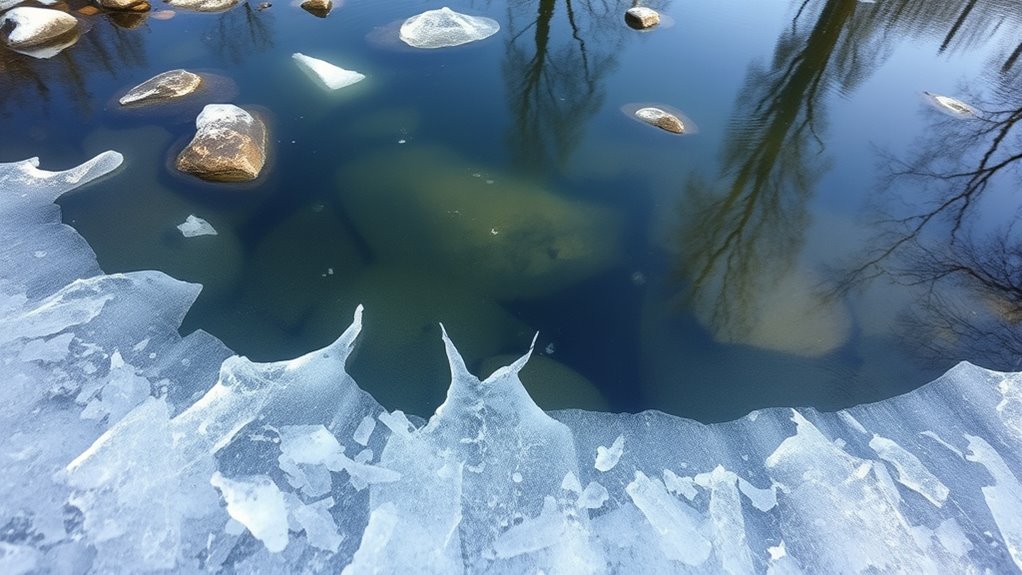
Water exhibits a remarkable and counterintuitive behavior near freezing: its density reaches a maximum at about 4°C. Instead of continuously increasing as it cools, water’s density peaks there and then decreases as the temperature drops further. This means that water colder than 4°C actually becomes less dense and tends to rise above slightly warmer water.
This anomaly influences how lakes and rivers stratify, creating layers that mix in unique patterns. It’s also vital for life, as it keeps water beneath ice from freezing solid, maintaining liquid habitats during winter.
Unlike most substances that contract when cooled, water’s expansion below 4°C results from the formation of open molecular structures. This peculiar behavior fundamentally affects aquatic environments and highlights water’s extraordinary physical properties.
How Hydrogen Bonds Shape Water’s Molecular Structure
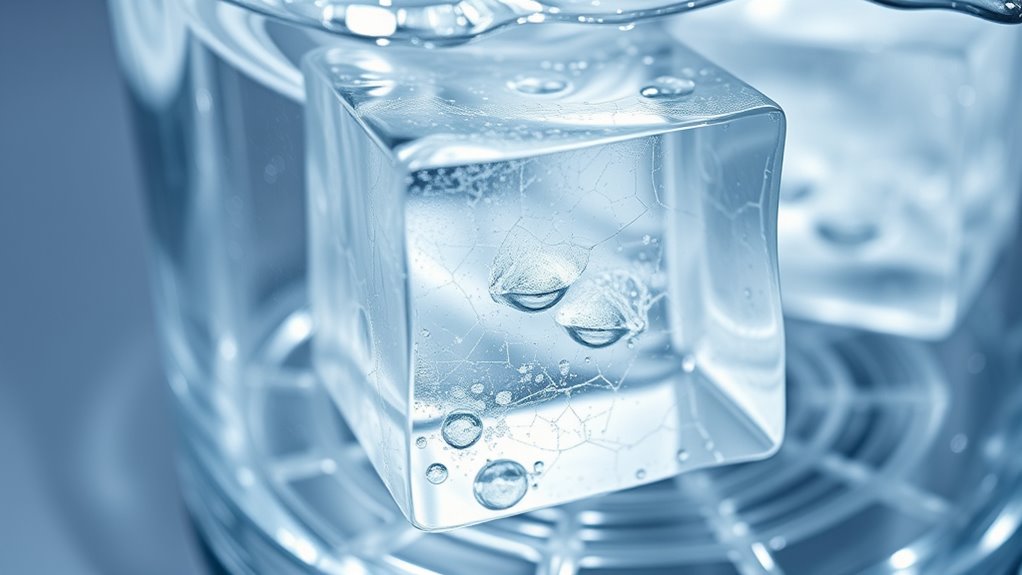
Hydrogen bonds are the key to understanding water’s distinctive molecular structure. Each water molecule can form up to four hydrogen bonds—two through its hydrogen atoms and two via lone pairs on oxygen. These bonds arrange tetrahedrally around each molecule, mimicking ice’s structure.
Typically, about 80% of water molecules form one strong and one weak hydrogen bond, while 20% create fully tetrahedral clusters. This dynamic network constantly fluctuates on an ultrafast timescale, shaping water’s properties.
The bent shape of water, with a 104.5° angle, and hydrogen bonding create directional forces, giving water high cohesion and surface tension. These bonds are responsible for water’s unique behavior, influencing everything from its boiling point to its ability to form extensive intermolecular networks.
The Role of Ice’s Tetrahedral Cage Formation

The unique molecular arrangement in water influences how ice forms and its physical properties. In ice, each water molecule adopts a tetrahedral shape, bonding to four neighbors through hydrogen bonds. This creates a cage-like structure, with open spaces that give ice its characteristic low density. HEPA filters are often used in air purifiers to capture tiny airborne particles, further enhancing indoor air quality. These tetrahedral cages form an extensive network that maintains the crystal’s stability and shape. Because of this open lattice, ice is less dense than liquid water, enabling it to float. The hydrogen bonds act as the backbone of this cage formation, holding the molecules in a rigid, yet open structure. This arrangement not only explains ice’s buoyancy but also accounts for its remarkable physical properties, such as rigidity and low density, compared to liquid water. The hydrogen bonding network is crucial in maintaining this unique structure under various environmental conditions. Additionally, this anomalous expansion is a rare phenomenon among substances, highlighting water’s special molecular behavior.
Why Water Expands When It Cools Below 4°C
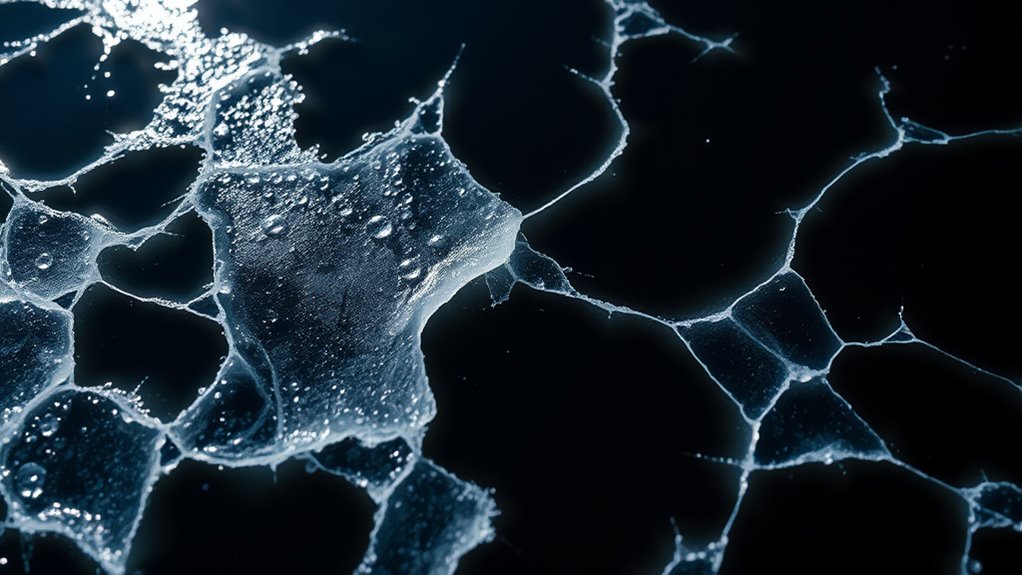
Unlike most substances, cooling below 4°C causes water to expand instead of contract. This anomaly occurs because, as water cools past its maximum density point, its molecules begin to arrange into a less dense structure. A key factor in this behavior is the formation of more hydrogen bonds, which facilitates the creation of an open, hexagonal pattern similar to ice’s structure. This process results in an increase in volume and a decrease in density. The hydrogen bonding in water is crucial for this behavior, as it facilitates the formation of these open molecular arrangements. The thermal expansion coefficient becomes negative below 4°C, signaling expansion during cooling. This behavior is vital for maintaining lakes’ temperature layers, as warmer water sinks below colder water, preventing the entire body from freezing. Understanding this expansion helps explain water’s unique physical properties and its role in ecological and environmental systems. This phenomenon is also influenced by hydrogen bonding, which plays a crucial role in water’s anomalous expansion.
The Contrast Between Water and Most Substances in Thermal Expansion
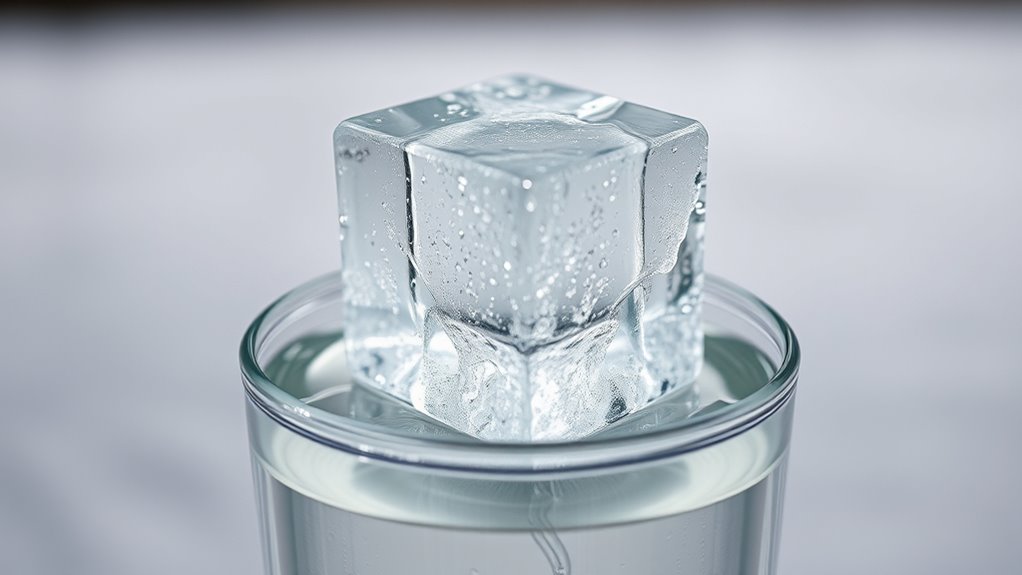
Most substances expand when their temperature increases, a behavior that’s fundamental to understanding material properties. Typically, heating causes molecules to move farther apart, leading to an increase in volume. Most materials, like metals and salts, have positive thermal expansion coefficients, meaning they consistently expand when warmed. Water, however, behaves differently. Below 4°C, it expands as it cools, which is unusual compared to most substances that contract when cooled. This anomalous expansion results from water’s unique hydrogen bonding and molecular structure. Unlike solids with rigid bonds, liquids like water lack fixed shapes, so their volume changes more freely. The molecular structure of water is responsible for its irregular behavior, which notably influences natural phenomena such as the formation of ice on lakes and ponds. Additionally, this anomalous expansion plays a crucial role in phenomena such as ice floating and the regulation of ocean temperatures. This behavior is closely linked to the density variations of water at different temperatures, impacting ecological and climatic systems.
Ecological Significance of Ice Floating on Water Bodies

Water’s unusual expansion behavior below 4°C influences how ice forms and floats on its surface. When water freezes, it creates a protective insulating layer that shields aquatic life from extreme cold. This layer prevents lakes and ponds from freezing solid, maintaining liquid habitats beneath and allowing fish and plants to survive harsh winters. Additionally, the unique properties of water impact the efficiency of sound recording techniques in field environments, emphasizing the importance of proper equipment handling in various conditions. The ice also reduces heat loss and stabilizes temperatures, supporting ecosystem stability. Floating ice safeguards aquatic organisms and plants from mechanical damage and provides refuges during winter. Additionally, ice influences oxygen and gas exchange—photosynthetic algae beneath can continue producing oxygen if light penetrates, but thick ice may cause hypoxia. Overall, ice’s presence sustains biodiversity, buffers environmental fluctuations, and reflects climate changes affecting aquatic ecosystems.
Educational Insights Into Water’S Anomalous Expansion

Understanding water’s anomalous expansion is essential for appreciating its unique behavior during cooling and freezing. You can observe this by performing simple experiments at home, such as monitoring water’s volume as it cools below 4°C.
Discover how cooling water below 4°C causes it to expand, highlighting its unusual behavior and the role of molecular structure.
As water approaches this temperature, it reaches maximum density, then begins to expand as it cools further, which is unusual compared to most substances. Using common materials, you can measure these changes and understand that hydrogen bonds cause water to expand when freezing.
This expansion makes ice less dense than liquid water, allowing it to float. Visualizing and measuring these effects helps you grasp why water behaves differently and highlights the importance of molecular structure in its anomalous expansion.
Engaging with hands-on experiments makes these concepts clear and memorable.
Frequently Asked Questions
How Does Water’s Molecular Structure Influence Its Density Changes?
You see, water’s molecular structure, especially hydrogen bonding, causes its density to change with temperature.
When water freezes, hydrogen bonds form a rigid, open lattice, spacing molecules farther apart and lowering density.
As you warm or cool water, molecular arrangements shift, creating voids or tighter clusters.
These structural changes explain why water’s density isn’t straightforward, leading to phenomena like ice floating and water’s unusual thermal properties.
Why Does Ice Have a Lower Density Than Liquid Water?
Think of water molecules as dancers in a carefully choreographed ballet. When water freezes, these dancers form a rigid, open lattice stabilized by hydrogen bonds.
This causes them to spread out instead of packing tightly.
This arrangement makes ice occupy more space than liquid water, lowering its density.
How Does the Anomalous Expansion Affect Aquatic Ecosystems?
You might wonder how anomalous expansion impacts aquatic ecosystems. It creates a floating ice layer that insulates water below, keeping temperatures stable and preventing the entire body from freezing.
This insulation allows aquatic life to survive harsh winters, maintains oxygen flow, and supports ecosystems. The expansion also influences water movement and physical structures, ensuring habitat stability and ecosystem resilience during seasonal changes.
What Role Do Hydrogen Bonds Play in Water’s Unique Properties?
Imagine hydrogen bonds as the invisible threads weaving water molecules into a delicate, interconnected web. These bonds give water its unique properties by creating high surface tension, high boiling points, and the ability to dissolve many substances.
They form a flexible, dynamic network that responds to temperature changes—expanding when cooled and contracting when heated—making water truly extraordinary and essential for life’s balance.
How Is Water’S Density Behavior Different From Other Liquids?
You notice that water behaves differently than most liquids when cooling. Instead of continuously getting denser, water reaches maximum density at 4°C and then becomes less dense as it freezes.
This happens because hydrogen bonding creates an open structure in ice, making it less dense than liquid water. Unlike other liquids that pack tighter when cooled, water expands upon freezing, leading to its unique density behavior.
Conclusion
So, next time you see ice floating, remember it’s all about water’s unique molecular structure and hydrogen bonds. This anomaly keeps aquatic life safe in winter and shapes our planet’s ecosystems. Isn’t it fascinating how such a simple molecule can have such complex behavior? Understanding why ice floats helps you appreciate nature’s clever design and the delicate balance that sustains life on Earth. Isn’t science amazing?
